人教版新目标九年级英语Unit9单元集体备课教案
- 格式:doc
- 大小:172.00 KB
- 文档页数:20
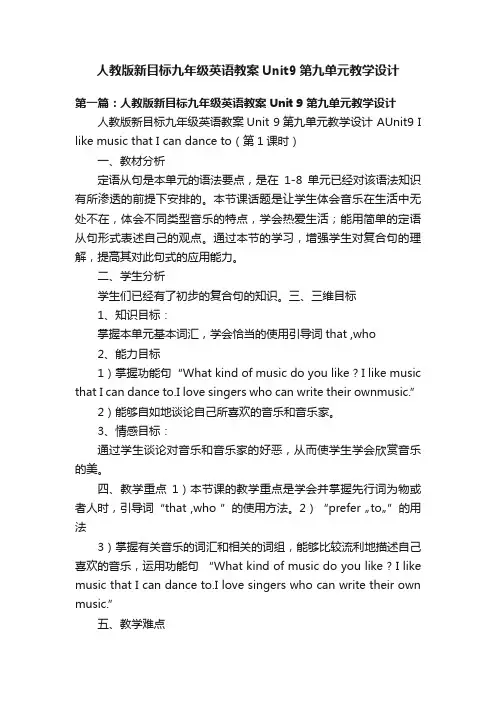
人教版新目标九年级英语教案Unit9第九单元教学设计第一篇:人教版新目标九年级英语教案Unit 9第九单元教学设计人教版新目标九年级英语教案Unit 9第九单元教学设计 AUnit9 I like music that I can dance to(第1课时)一、教材分析定语从句是本单元的语法要点,是在1-8单元已经对该语法知识有所渗透的前提下安排的。
本节课话题是让学生体会音乐在生活中无处不在,体会不同类型音乐的特点,学会热爱生活;能用简单的定语从句形式表述自己的观点。
通过本节的学习,增强学生对复合句的理解,提高其对此句式的应用能力。
二、学生分析学生们已经有了初步的复合句的知识。
三、三维目标1、知识目标:掌握本单元基本词汇,学会恰当的使用引导词that ,who2、能力目标1)掌握功能句“What kind of music do you like ? I like music that I can dance to.I love singers who can write their ownmusic.”2)能够自如地谈论自己所喜欢的音乐和音乐家。
3、情感目标:通过学生谈论对音乐和音乐家的好恶,从而使学生学会欣赏音乐的美。
四、教学重点1)本节课的教学重点是学会并掌握先行词为物或者人时,引导词“that ,who ”的使用方法。
2)“prefer …to…”的用法3)掌握有关音乐的词汇和相关的词组,能够比较流利地描述自己喜欢的音乐,运用功能句“What kind of music do you like ? I like music that I can dance to.I love singers who can write their own music.”五、教学难点定语从句运用六、教学策略采用任务型语言教学,实施情境教学法、小组合作探究法、情感激励法。
七、教学准备自制多媒体课件(PowerPoint);录音机(A tape recorder)八、教学环节1、课堂导入⑴ Warming up ⑵ Discuss: Do you like music? What kind ofmusic do you know? ⑶ There aremany kinds of music such as pop ,jazz, rock…….Let Sstalk about the kinds of music..(多媒体出示)⑷Let Ss read 1a.Explain the sentences: I prefermusic that has great lyrics=I like music that has great lyrics better.lyrics:the plural form is often used.Ask Ss topractice in pairs then make up a short passage using the four sentences on thescreen.2、课堂讲授Explain attributive clauses.定语从句:在复合句中修饰名词或者代词的从句叫做定语从句。
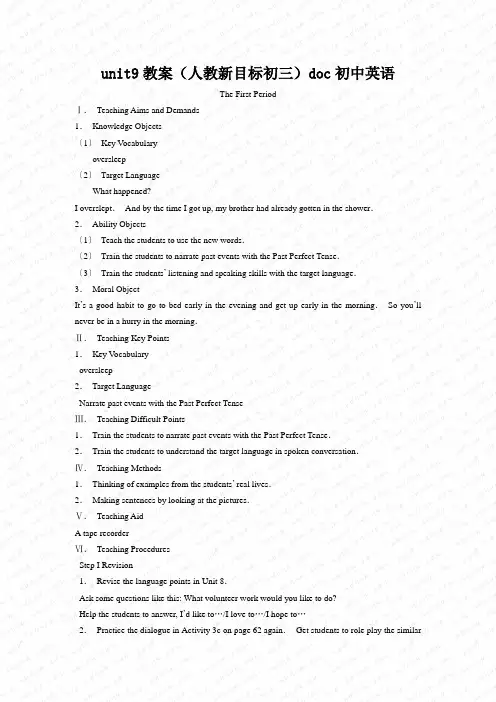
unit9教案(人教新目标初三)doc初中英语The First PeriodⅠ.Teaching Aims and Demands1.Knowledge Objects〔1〕Key Vocabularyoversleep〔2〕Target LanguageWhat happened?I overslept.And by the time I got up, my brother had already gotten in the shower.2.Ability Objects〔1〕Teach the students to use the new words.〔2〕Train the students to narrate past events with the Past Perfect Tense.〔3〕Train the students’ listening and speaking skills with the target language.3.Moral ObjectIt’s a good habit to go to bed early in the evening and get up early in the morning.So you’ll never be in a hurry in the morning.Ⅱ.Teaching Key Points1.Key Vocabularyoversleep2.Target LanguageNarrate past events with the Past Perfect TenseⅢ.Teaching Difficult Points1.Train the students to narrate past events with the Past Perfect Tense.2.Train the students to understand the target language in spoken conversation.Ⅳ.Teaching Methods1.Thinking of examples from the students’ real lives.2.Making sentences by looking at the pictures.Ⅴ.Teaching AidA tape recorderⅥ.Teaching ProceduresStep I Revision1.Revise the language points in Unit 8.Ask some questions like this: What volunteer work would you like to do?Help the students to answer, I’d like to…/I love to…/I hope to…2.Practice the dialogue in Activity 3c on page 62 again.Get students to role play the similardialogues with the following.S A: I’d like to join the school volunteer project, but I’m not sure what I should do.S B: What do you like doing?S A: I love playing football.S B: Well, you could help coach a football team for little kids.Let the children practice in pairs.3.Check the students’homework by asking some students to read their sentences with the phrasal verbs.Then ask the students to hand in their homework.4.Dictate the following words:clean up, cheer up, give out, put off, set up, run out of, take after, fix up, giveaway, call up, hand out, work out, hunger, establish, commitment, veterinarian, strategyStep Ⅱ1aThis activity introduces new vocabulary which can be used to narrate past events.First write by the time on the blackboard.and tell the class the meaning of it."by the time" means not later than, before, as soon as, or when the indicated comes.When we use the words."By the time…, "we are talking about two different things that happened in the past.Say this sentence to the class: By the time the teacher came in, the students had begun reading English.Tell them to note the struture "had begun" in this sentence.Begun is the past participle of begin.When we talk about two events both happened in the past, the one which happened earlier should use and plus a past participle.The words following By the time…, talk about the thing that happened later.And tell the students when they use had plus a past participle, they are using the Past Perfect Tense.Also explain what is the past participle form of a verb for the students.Tell them it is as the same as the past form for a regular verb.And they have to remember the irregular verbs’ participles one by one.Play a game to help the students understand the sentences with the words By the time…Do it like this:Pretend that the teacher will leave the classroom and the students will do some things.When the teacher returns.the class will make statements starting with By the time…Write By the time I came back…on the blackboard.Say to the class, By the time I came in.what had happened?Help one student to answer like this, By the time the teacher came in, Don had written his name on the blackboard.Then get more students to answer differently, such as,By the lime the teacher came in, we had discussed an English problem.By the time the teacher came in, I had drawn a picture.Write these sentences on the blackboard, and teach the students to read several times.Read the instructions to the students and read these questions to the class as well.What do you usually do in, the morning before school? Do you like morning?Why or why not?Choose one good student to answer them by saying something he or she usually does in the morning.He or she may answer like this,I usually get up early, wash my face and have breakfast.I like mornings because the air is fresh, or I usually get up as late as possible.Then I have to wash my face and have breakfast in a hurry.I often rush to school without breakfast.Sometimes I forget something at home.I don’t like mornings because I am always too busy.Then have the whole class practice in pairs.Ask each other the questions.After they finish talking, ask one or two pairs to say their conversations to the class.Correct the mistakes they may make with the other students.Call the students’ attention to the pictures in Activity la.Ask students to tell what they see.Say, Any sentences which make sense are accepted to describe the pictures.The girl in the pictures is Tina.Present the new words by providing sentences showing the meanings of them like this:T: What can you see in Picture 1?S1: She slept a long time.T: That’s correct.She slept too late.She overslept.Class repeat.She overslept.S s: She overslept.T: What do you see in Picture 2?S2: Her brother or sister is in the bathroom.T: That’s correct.She wants to go into the bathroom.She can’t because someone is taking a shower.Class repeat.Someone is taking a shower.S s: Someone is taking a shower.Write these words on the blackboard:overslept, taking a shower, had left, left her backpack at home.Then tell students to talk about the pictures in groups of four.Move around the classroom, listening to students and offering help.Make sure that they talk in English.After they all finish talking, ask different groups to tell the class about the pictures.They may say like this:Tina overslept in the morning.She wanted to go to the bathroom, but her brother had already gotten in the shower.When she got to the bus stop, the bus had already left.She had to run to school.After she got to school, she realized she had left her backpack at home.The sentences can vary, but should be correct.Step Ⅲ1bThis activity gives students practice in understanding the target language in spoken conversation.Ask the students to read the instructions together.Have them look at the two columns, A and B ,in the chart.Point out the sample answer.Read the two parts of the sentence.Then go over the other unconnected parts of sentences, too.You will connect the two parts of the sentences, connect a sentence beginning in the first column with the end of that sentence in the second column.Please guess the other two sentences before I play the tape.I guess most of the children can get the correct sentences by guessing.So just let them guess.Don’t tell them whether their answers are right or wrong.OK, just keep your answers by guessing.Let’s decide if they are right by listening to the tape now.Play the recording for the first time.Students only listen.Then play it a second time.Let students match two parts of each sentence.Check the answers by asking some students to tell their answers.Make sure that all of them have got the correct answers by listening.Say congratulations to the students who get the answers correctly by guessing.Answers1.b 2.a 3.cTapescriptBoy: Hi, Tina.You look stressed out.Girl: I am.I had a bad morning.Boy: Really? What happened?Girl: Well, first of all I overslept.By the time I got up, my brother had already gotten in the shower.Boy: Oh, what a pain!Girl: So, after he got out of shower, I took a quick shower and got dressed.But by the time I went outside, the bus had already left.Boy: Oh, no!Girl: Oh, yes! So I ran all the way to school.But when I got to school, I realized I had left my backpack at home.Boy: No wonder you look stressed out.Step Ⅳ1cThis practice provides guided oral practice using the target language.First play the recording in Activity 1bagain and let the students read after it.Do it at least twice.Then read the instructions together with the whole class.You will make conversations in pairs.Each of you will have to take turns being Tina.Look at the pictures in Activity la to help you.Tell your partner what happened to you this morning.Ask a pair to read the example to the class before they begirtS A: What happened?S B: I overslept.And by the time I got up, my brother had already gotten in the shower.Write the conversation on the blackboard.Have the students work in pairs.Move around the room offering language support as needed.After they all finish talking, ask some pairs to say their conversations to the class.Step ⅤSummarySay, In this class, we’ve learned how to narrate past events, using the Past Perfect Tense.We’ve also done some listening practice in understanding the target language in spoken conversation.Also, we’ve done much oral practice using the target language.Step ⅥHomework1.Write out the story of Tina, Note to use the target language.2.Revise when to use the Past Perfect Tense and the verb structure of it.Step ⅦBlackboard DesignUnit 9 By the time I got outside, thebus had already left.Section AThe First Period1.By the time…By the time the teacher came in, the students had begun reading.By the time the teacher came in, Don had written his name on the blackboard.By the time the teacher came m, we had discussed an English problem.2.Some words to describe the pictures overslept, taking a shower, had left, left herbackpack at home.3.Target Language:A: What happened?B:I overslept.And by the time I got up, my brother had already gottenin the shower.。
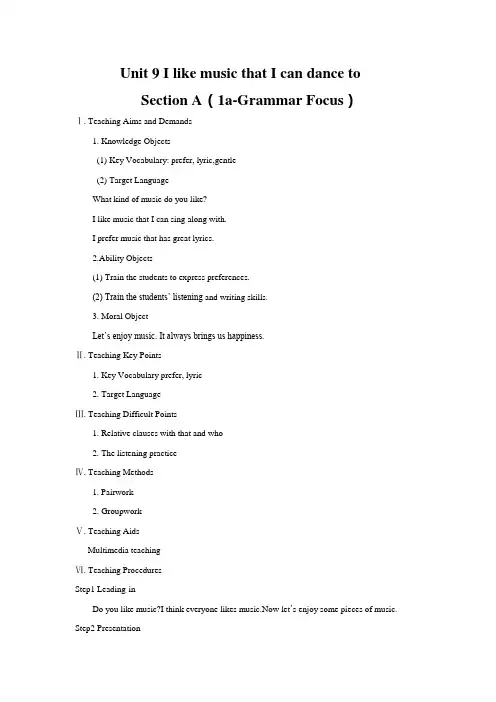
Unit 9 I like music that I can dance toSection A(1a-Grammar Focus)Ⅰ. Teaching Aims and Demands1. Knowledge Objects(1) Key Vocabulary: prefer, lyric,gentle(2) Target LanguageWhat kind of music do you like?I like music that I can sing along with.I prefer music that has great lyrics.2.Ability Objects(1) Train the students to express preferences.(2) Train the students’ listening and writing skills.3. Moral ObjectLet’s enjoy music. It always brings us happiness.Ⅱ. Teaching Key Points1. Key Vocabulary prefer, lyric2. Target LanguageⅢ. Teaching Difficult Points1. Relative clauses with that and who2. The listening practiceⅣ. Teaching Methods1. Pairwork2. GroupworkⅤ. Teaching AidsMultimedia teachingⅥ. Teaching ProceduresStep1 Leading-inDo you like music?I think everyone likes music.Now let’s enjoy some pieces of music.Step2 PresentationPlay a piece of music.Then ask the students:Do you like the music?What do you think ofit?Help the students to answer it.Then say , I like music that I can dance to.In this way,play some other kinds of music for the students and let them try to say “Ilike/prefer music that has great lyrics,…that I can sing along with,…that isn’t too loud, …”. Tell the students prefer means like …better.(设计意图:先描述对各种音乐的感觉,引导学生学会用定语从句表达自己喜欢的各种音乐。
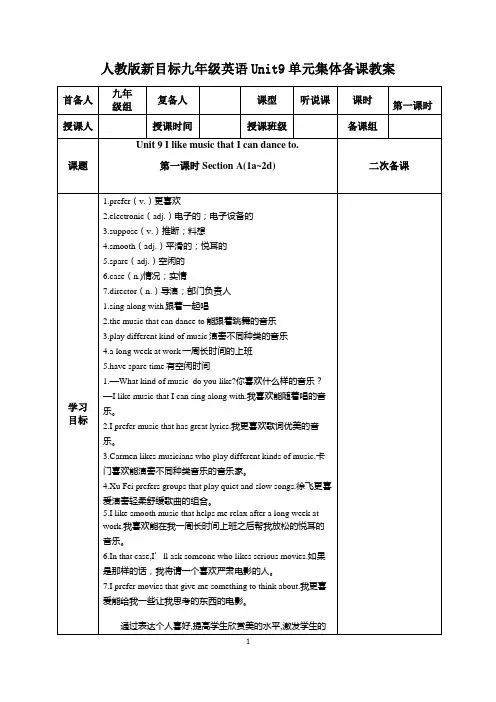
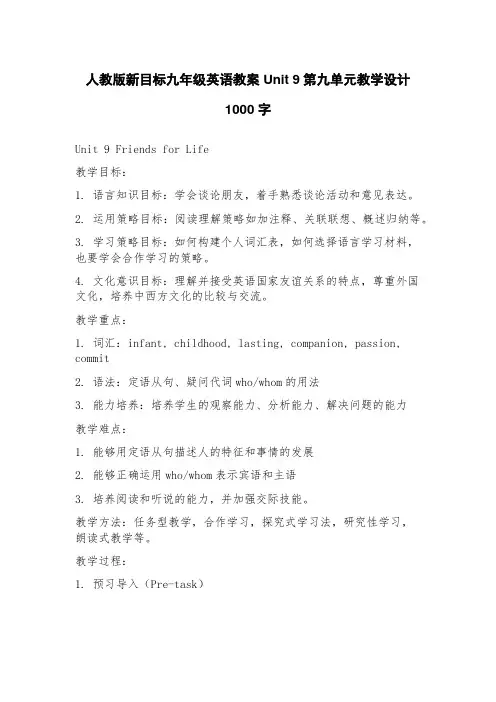
人教版新目标九年级英语教案Unit 9第九单元教学设计1000字Unit 9 Friends for Life教学目标:1. 语言知识目标:学会谈论朋友,着手熟悉谈论活动和意见表达。
2. 运用策略目标:阅读理解策略如加注释、关联联想、概述归纳等。
3. 学习策略目标:如何构建个人词汇表,如何选择语言学习材料,也要学会合作学习的策略。
4. 文化意识目标:理解并接受英语国家友谊关系的特点,尊重外国文化,培养中西方文化的比较与交流。
教学重点:1. 词汇:infant, childhood, lasting, companion, passion, commit2. 语法:定语从句、疑问代词who/whom的用法3. 能力培养:培养学生的观察能力、分析能力、解决问题的能力教学难点:1. 能够用定语从句描述人的特征和事情的发展2. 能够正确运用who/whom表示宾语和主语3. 培养阅读和听说的能力,并加强交际技能。
教学方法:任务型教学,合作学习,探究式学习法,研究性学习,朗读式教学等。
教学过程:1. 预习导入(Pre-task)通过显示26个英文字母,让学生回忆并列出所有以字母“F”开头的词汇,包括名词、形容词和动词。
教师在课堂前五分钟录下结果。
集体看一看,并补全缺少的词汇。
2. 输入新信息(Input)(1)任务1 完形填空让学生看到P63-P64的Team Building后,完成练习。
(2)任务2 阅读理解让学生阅读第一篇文章。
找到文章中描述朋友关系的词句,把它们圈起来。
(只用一分钟)接着,再读文章一遍,用自己的话回答问题。
(3)任务3 语法:定语从句a. 回忆练习:请学生跟随老师大声读一遍P66中的例句,并在课本上用横线把定语从句圈出来。
b. 给出Grammars P93中的定语从句。
分类规定。
c. 设计练习。
请学生阅读P93中的定语从句,并按照汉语意思,写出英语句子。
例如:我能听懂讲师讲英语的课。
![新目标英语九年级教案unit9-新人教[全套]](https://uimg.taocdn.com/454c467477232f60ddcca14e.webp)
新目标英语九年级教案unit9-新人教[全套]Unit 9 By the time I got outside, the bus had already left. The First Period Ⅰ. Teaching Aims and Demands 1. Knowledge Objects (1) Key Vocabulary oversleep (2) Target Language What happened? I overslept. And by the time I got up, my brother had already gotten in the shower. 2. Ability Objects (1) Teach the students to use the new words.(2) Train the students to narrate past events with the Past Perfect Tense.(3) Train the students’listening and speaking skills with the target language. 3. Moral Object It’s a good habit to go to bed early in the evening and get up early in the morning. So you’ll never be in a hurry in the morning.Ⅱ. Teaching Key Points 1. Key Vocabulary oversleep 2. Target Language Narrate past events with the Past Perfect Tense Ⅲ. Teaching Difficult Points 1. Train the students to narrate past events with the Past Perfect Tense. 2. Train the students to understand the target language in spoken conversation.Ⅳ. Teaching Methods 1. Thinking of examples from the students’ real lives. 2. Making sentences by looking at the pictures.Ⅴ. Teaching Aid A tape recorder Ⅵ. Teaching Procedures Step I Revision 1. Revise the language points in Unit 8. Ask some questions like this: What volunteer work would you like to do? Help thestudents to answer, I’d like to…/I love to…/I hope to… 2. Practice the dialogue in Activity 3c on page 62 again. Get students to role play the similar dialogues with the following. SA: I’d like to join the school volunteer project, but I’m not sure what I should do. SB: What do you like doing? SA: I love playing football. SB: Well, you could help coacha football team for little kids. Let the children practice in pairs. 3. Check the students’ homework by asking some students to read their sentences with the phrasal verbs. Then ask the students to hand in their homework. 4. Dictate the following words: clean up, cheer up, give out, put off, set up, run out of, take after, fix up, give away, call up, hand out, work out, hunger, establish, commitment, veterinarian, strategy Step Ⅱ 1a This activity introduces new vocabulary which can be used to narrate past events. First write by the time on the blackboard. and tell the class the meaning of it. "by the time" means not later than, before, as soon as, or when the indicated comes. When we use the words. "By the time…, "we are talking about two different things that happened in the past. Say this sentence to the class: By the time the teacher came in, the students had begun reading English. Tell them to note the struture "had begun" in this sentence. Begun is the past participle of begin. When we talk about two events both happened in the past, the one which happened earlier should use and plus a past participle. The words following By the time…, talk about the thing thathappened later. And tell the students when they use had plus a pastparticiple, they are using the Past Perfect Tense. Also explain what isthe past participle form of a verb for the students. Tell them it is asthe same as the past form for a regular verb. And they have to rememberthe irregular verbs’ participles one by one. Play a game to help thestudents understand the sentences with the words By the time…Do it likethis: Pretend that the teacher will leave the classroom and the studentswill do some things. When the teacher returns. the class will makestatements starting with By the time… Write By the time I came back…on the blackboard. Say to the class, By the time I came in. what hadhappened? Help one student to answer like this, By the time the teachercame in, Don had written his name on the blackboard. Then get more studentsto answer differently, such as, By the lime the teacher came in, we haddiscussed an English problem. By the time the teacher came in, I had drawna picture. Write these sentences on the blackboard, and teach the studentsto read several times. Read the instructions to the students and readthese questions to the class as well. What do you usually do in, the mornin。

人教版新目标九年级英语Unit9单元集体备课教案Unit 9: I Like Music That I Can Dance ToIn this unit。
we will learn some new vocabulary words and phrases such as "prefer," "electronic," "suppose," "smooth," "spare," "case," and "director." We will use these words to talk about our XXX.When someone asks us what kind of music we like。
we can answer by saying。
"I like music that I can sing along with." This means that we enjoy singing along to the music we listen to。
Another way to express our preference is by saying。
"I prefer music that has great lyrics." This means that we enjoy music with beautiful and meaningful lyrics.We can also talk about our friends' XXX。
XXX who play different kinds of music。
This means that she XXX who can playdifferent genres of music。
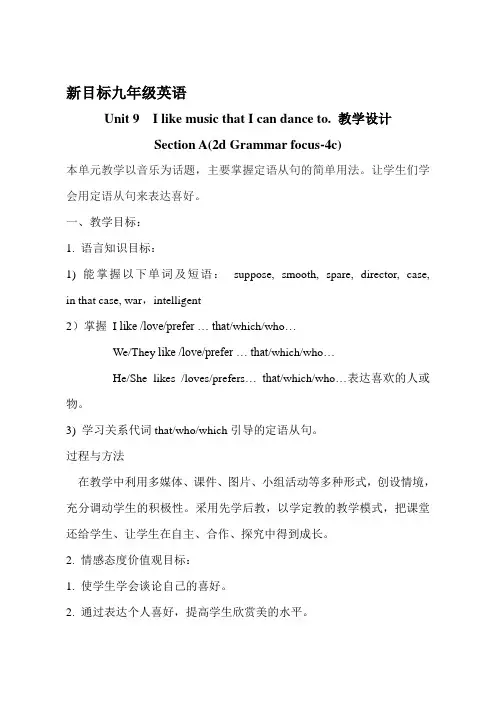
新目标九年级英语Unit 9 I like music that I can dance to. 教学设计Section A(2d Grammar focus-4c)本单元教学以音乐为话题,主要掌握定语从句的简单用法。
让学生们学会用定语从句来表达喜好。
一、教学目标:1. 语言知识目标:1) 能掌握以下单词及短语:suppose, smooth, spare, director, case, in that case, war,intelligent2)掌握I like /love/prefer … that/which/who…We/They like /love/prefer … that/which/who…He/She likes /loves/prefers… that/which/who…表达喜欢的人或物。
3) 学习关系代词that/who/which引导的定语从句。
过程与方法在教学中利用多媒体、课件、图片、小组活动等多种形式,创设情境,充分调动学生的积极性。
采用先学后教,以学定教的教学模式,把课堂还给学生、让学生在自主、合作、探究中得到成长。
2. 情感态度价值观目标:1. 使学生学会谈论自己的喜好。
2. 通过表达个人喜好,提高学生欣赏美的水平。
3. 激发学生的学习兴趣和学习热情。
二、教学重难点1. 教学重点:1)suppose, smooth,spare,director,case,in the case,war的用法。
2)句型:I like music that/which I can sing along with.She likes musicians who play different kinds of music.2. 教学难点:学习关系代词that/who/which引导的定语从句。
教学过程Step 1 Warming up1.Free talk. Ask “What kind of music/movies do you like?”I like musicthat/which/who …2.Have students report their answers to the whole class.【设计意图】课前热身,通过小对话交流简单了解个人喜好,再用知识扩充的形式去帮助学生认识和了解各种音乐类型的表达方式,很好地为接下来的个人喜好交流奠定基础。
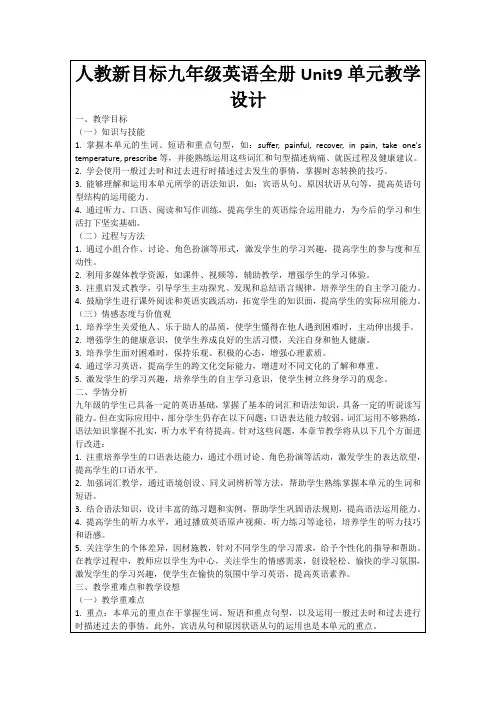
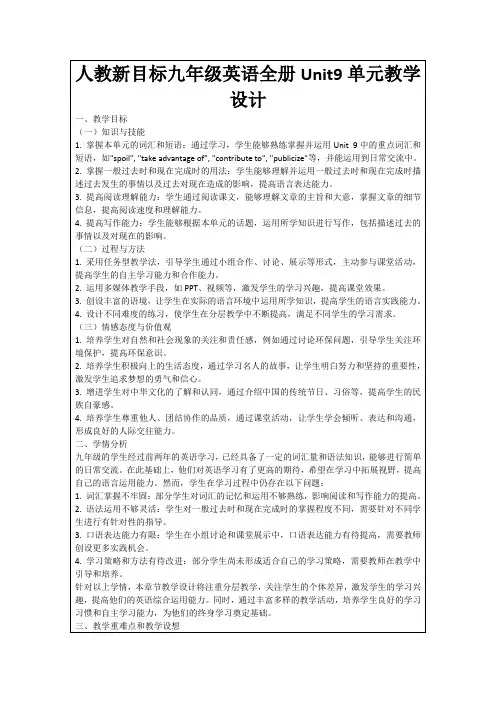
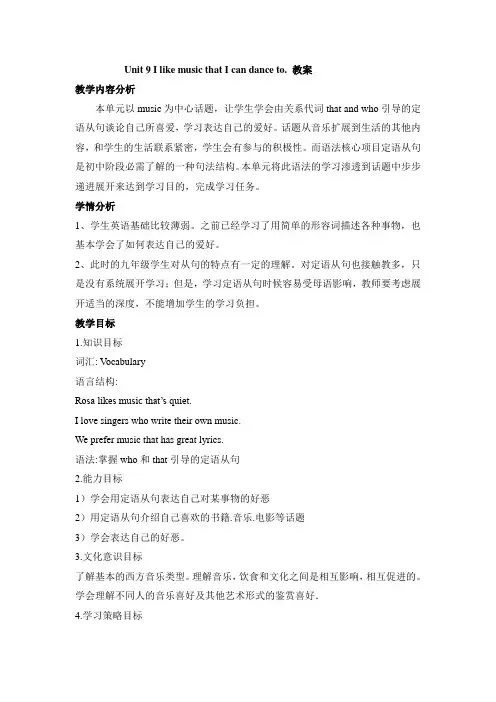
Unit 9 I like music that I can dance to. 教案教学内容分析本单元以music为中心话题,让学生学会由关系代词that and who引导的定语从句谈论自己所喜爱,学习表达自己的爱好。
话题从音乐扩展到生活的其他内容,和学生的生活联系紧密,学生会有参与的积极性。
而语法核心项目定语从句是初中阶段必需了解的一种句法结构。
本单元将此语法的学习渗透到话题中步步递进展开来达到学习目的,完成学习任务。
学情分析1、学生英语基础比较薄弱。
之前已经学习了用简单的形容词描述各种事物,也基本学会了如何表达自己的爱好。
2、此时的九年级学生对从句的特点有一定的理解。
对定语从句也接触教多,只是没有系统展开学习;但是,学习定语从句时候容易受母语影响,教师要考虑展开适当的深度,不能增加学生的学习负担。
教学目标1.知识目标词汇: V ocabulary语言结构:Rosa likes music that’s quiet.I love singers who write their own music.We prefer music that has great lyrics.语法:掌握who和that引导的定语从句2.能力目标1)学会用定语从句表达自己对某事物的好恶2)用定语从句介绍自己喜欢的书籍.音乐.电影等话题3)学会表达自己的好恶。
3.文化意识目标了解基本的西方音乐类型。
理解音乐,饮食和文化之间是相互影响,相互促进的。
学会理解不同人的音乐喜好及其他艺术形式的鉴赏喜好.4.学习策略目标1)交际策略:通过讨论自己的爱好,对事物做出评论等方式,交流彼此的观点,相互学习。
2)资源策略:充分利用各种媒体资源,感受不同的音乐和电影,为语言学习创造更多的情境与机会。
5.情感目标1)通过讨论自己的喜好,促进养成健康向上的生活习惯。
如健康的饮食习惯。
2)通过学习写评论,学习正确评论事物,形成健康的审美情趣。
人教版新目标九年级英语Unit9单元教案Unit 9 I like music that I can dance to.Section A (1a-2d)学习目标1.重点单词:prefer,lyrics,Australian,electronic,suppose,smooth,spare,case,director,war2.重点短语:sing along with,dance to,different kinds of,in that case3.重点句式:—What kind of music do you like?—I like music that I can sing along with.Carmen likes musicians who play different kinds of music.I prefer movies that give me something to think about.学习重点1.重点短语和句型2.定语从句学习难点定语从句自主学习一、预习课本P65-66新单词并背诵,完成下面的汉译英。
1.更喜欢________ 2.歌词________3.电子的________ 4.推想________5.平滑的________ 6.空闲________7.情况________ 8.导演________9.战争________ 10.澳大利亚的________二、认真预习1a-2d找出下列短语和句型。
1.随之唱歌__________________________________________________________ ______________2.随着……跳舞__________________________________________________________ ______________3.不同种类的__________________________________________________________ ______________4.既然那样__________________________________________________________ ______________5.—你喜欢什么种类的音乐?—我喜欢能跟着唱的音乐。
Unit 9 I like music that I can dance to教学目标:能够听懂并口头表达关于音乐类型的信息。
能够用英语描述音乐、乐器、音乐家等。
能够通过听、说、读、写的综合训练提高英语综合运用能力。
教学重点:了解不同音乐类型的特点。
能够用英语描述音乐类型。
学会用定语从句描述自己喜欢的音乐。
教学难点:运用定语从句描述自己喜欢的音乐。
听力训练的提高。
教学准备:多媒体课件。
Unit 9的教材及练习题。
Step 1: Warm-upThe teacher plays a piece of music and encourages students to guess the genre of the music based on the melody and lyrics.The teacher randomly asks students about their knowledge of music.Step 2: PresentationThe teacher introduces different genres of music and plays music of different genres to help students understand the characteristics of each genre.The teacher guides students to discuss the differences between different types of music and to describe the characteristics of different genres of music in English.Step 3: PracticeThe teacher designs a listening exercise where a piece of music is played and students choose suitable adjectives to describe the song.The teacher designs an exercise where students describe their favorite type of music and use relative clauses to describe the genre of music they like.Students work in pairs to discuss their favorite music and share their descriptions using relative clauses.Step 4: Productionteacher asks students to work in small groups and create a playlist of songs for a specific event or occasion, such as a party, a wedding, or a workout session. Each group presents their playlist and explains the reason for choosing the songs.The teacher encourages students to share their opinions about different types of music and engage in a class discussion about the role of music in people's lives.Step 5: Review and AssessmentThe teacher reviews the vocabulary and grammar structures covered in the lesson and provides additional practice exercises to reinforce the learning.The teacher assesses students' understanding of the lesson through a quiz, a writing assignment, or a role-playing activity.The teacher provides feedback and guidance to help students improve their language skills and achieve their learning goals.For homework, students can:Write a paragraph about their favorite type of music and use relative clauses to describe the genre of music they like.Create a playlist of songs for a specific event or occasion and write a short explanation for why each song was chosen.Research a famous musician or band and write a short biography about them, including information about their music and achievements.Listen to a song in a foreign language and write a brief summary of the lyrics, including any new vocabulary or expressions they learned.Watch a movie or TV show that features music as a major theme or plot element, and write a review of the film, focusing on how the music enhances the story or characters.。